
Despite our best efforts, it’s incredibly challenging to remain at peak health throughout the year. Between illnesses, accidents, and simple misfortune, it’s relatively easy to suffer a complication that keeps you or a loved one out of the workforce for some time. If you’re injured or become ill due to workplace conditions, it’s likely that your injuries fall into the category of workers’ compensation (or workers’ comp). Workers’ comp replaces a portion of a wounded employee’s payroll wages and covers their medical expenses after an accident.
States have their own specific requirements, regulations, and laws that define the workers’ comp system under their jurisdiction. The rules and payment thresholds are determined by the state’s insurance regulators. Our team took a closer look at the overall wellness and workers’ comp situation in Connecticut. We developed a deeper understanding of the injuries and illnesses affecting workers in the state, as well as the number of cases and payout figures on an annual basis.
Table of Contents
ToggleTo immediately access the resources at any point on this page, click the appropriate link below.
What are Occupational Injuries, Illnesses, & Diseases?
Which Age Group is Most Affected By Occupational Illnesses in Connecticut?
Occupational Diseases Harming Workers in Connecticut
Exposure to Infectious Diseases in the Workplace
Non-Chronic Respiratory Poisonings & Illnesses by Cause in Connecticut
Chronic Lung Conditions
Miscellaneous Workplace Injuries & Complaints
Nonfatal Occupational Illnesses & Injuries in Connecticut Private Industries
Fatal Occupational Injuries in Connecticut
Comparing Fatal Occupational Injuries in the United States
Occupational Illnesses by Connecticut Town or Municipality
How Many Connecticut Workers’ Compensation Cases Have Been Filed in 2022?
What to Do if You’re Injured on the Job
To begin, we’ll discuss the types of harm that can befall an employee at their job. Some injuries are instantaneous, such as a worker being harmed by a defective piece of machinery on a factory floor. Other injuries take months or even years to be detected but can have a significant impact on the victim’s quality of life. For example, a construction worker may be diagnosed with lung cancer or mesothelioma after years of exposure to asbestos at different worksites.
Perhaps not surprisingly, the age groups that bear the brunt of occupational illnesses throughout the year are those aged twenty-five to sixty-four. As of 2019, just over 80% of Connecticut’s workforce fell into this age range. With relatively fewer workers younger than twenty-five or older than sixty-five in the workforce, it stands to reason that those age ranges would have fewer documented cases of illnesses. Arranged in the chart below are cases of occupational illness in Connecticut in 2019, categorized by age range. Data is drawn from the North American Industry Classification System (NAICS).
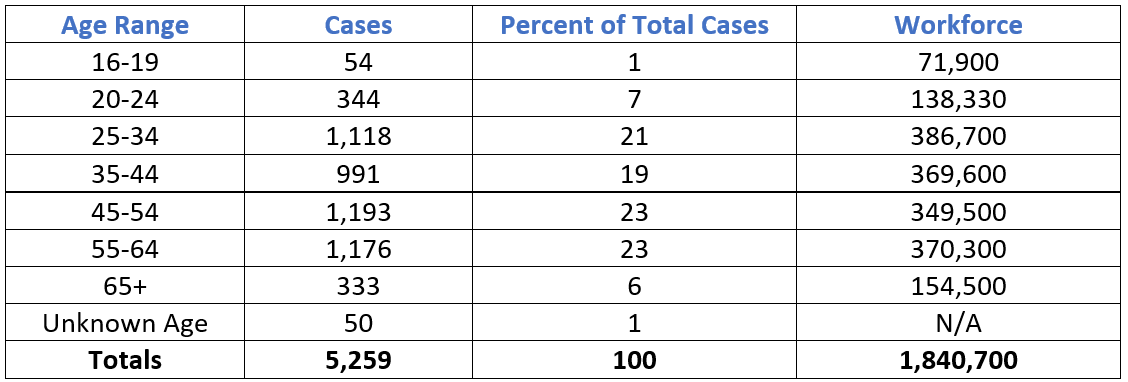
Due largely to complications of the ongoing Covid-19 pandemic, data on workplace illnesses for 2020 and 2021 has not been fully peer-reviewed and approved yet. However, we can look at data gathered from as recently as 2019. According to the Bureau of Labor Statistics (BLS) and Connecticut Department of Labor (CTDOL), there were roughly 1,700 reported instances of occupational illnesses in 2019. As displayed below, Connecticut had approximately 200 less reported occupational diseases in 2019 than in 2018. In both years, no cases of workplace-related poisonings were recorded. To remain faithful to the original data collection methods, we defined musculoskeletal disorders as “other,” as BLS does.
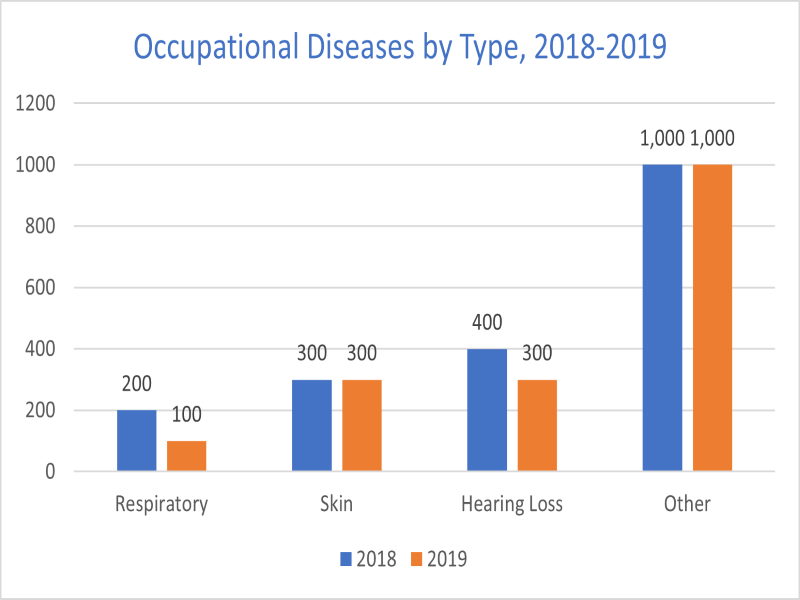
Unlike occupational diseases, which trended downwards from 2018 to 2019, contraction of and exposure to infectious diseases in Connecticut workplaces rose by 9%. In 2019, there were 1,063 reports of exposure to bloodborne pathogens. This marks a 6% increase from 2018, and these incidents accounted for 81% of statewide infectious disease reports.
In recent years, court decisions have expanded the definition of “compensable disease” via workers’ comp in Connecticut to include exposure. This helps injured workers secure the medical treatments they need to recover, without fighting a prolonged battle to prove that the first report of injury was not simply exposure to a disease but contraction of symptoms.
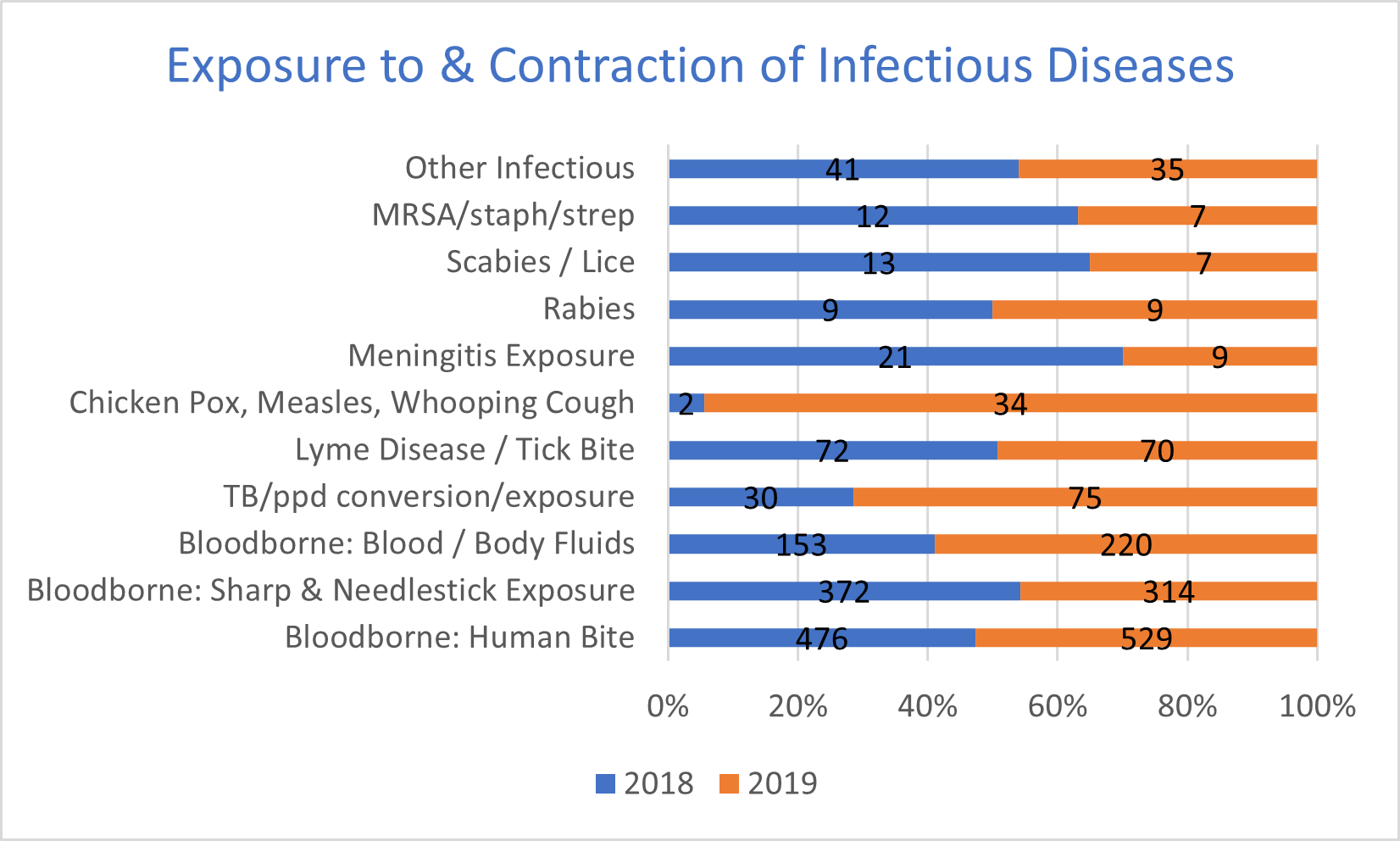
Respiratory illnesses and poisonings can cause catastrophic, life-changing harm. While some respiratory illnesses occur due to exposure over prolonged periods of time, others are caused by singular events, such as inhaling smoke during a fire or being exposed to deadly chemicals. From 2018 to 2019, non-chronic respiratory illnesses decreased by 9%.
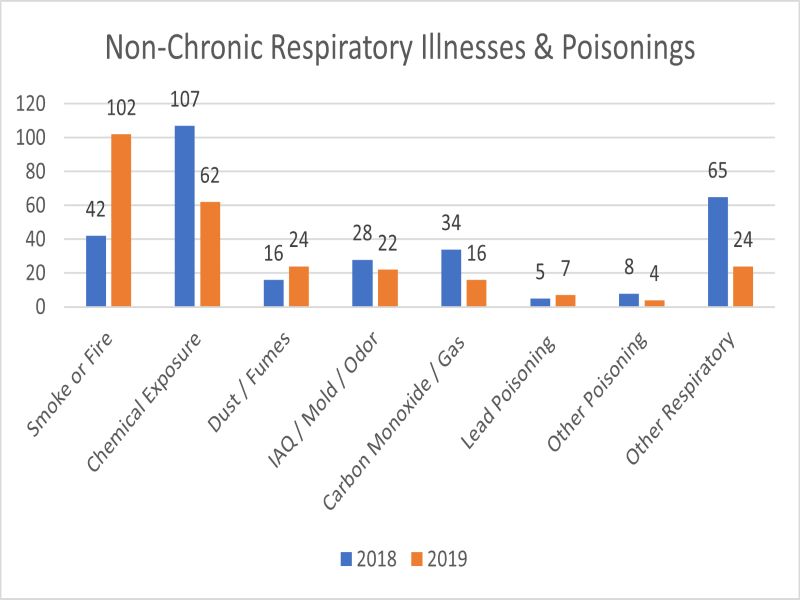
While non-chronic respiratory illnesses and poisonings decreased in 2019, chronic lung conditions increased by a staggering 43% from 2018. Of the total 187 reported chronic lung conditions, 54 were asbestos-related. In the chart below, all forms of cancer are categorized as “other chronic lung disease,” including those caused by asbestos exposure.
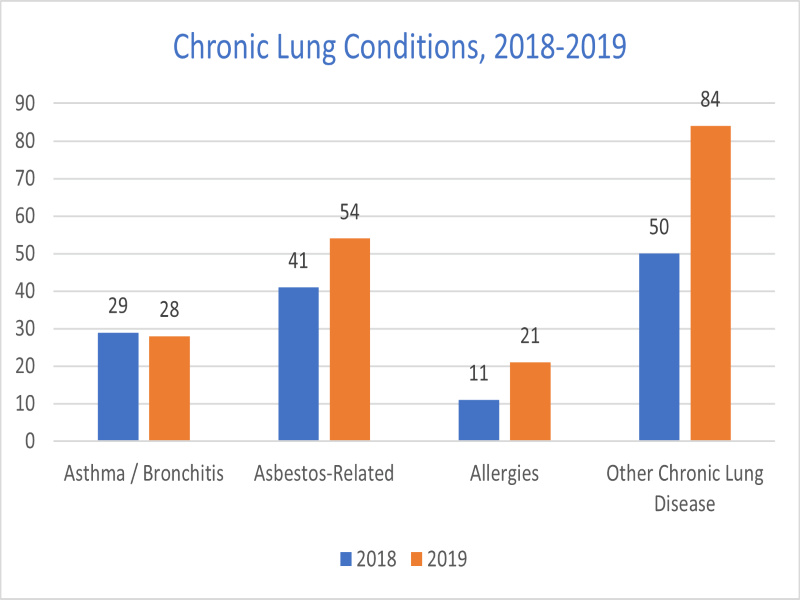
While catastrophic workplace accidents are what many people think of when they hear the phrase “workers’ comp,” there are a number of other conditions that can detrimentally impact one’s life. We’ve tracked some of these injuries and complaints from 2018 and 2019 in the graph below.
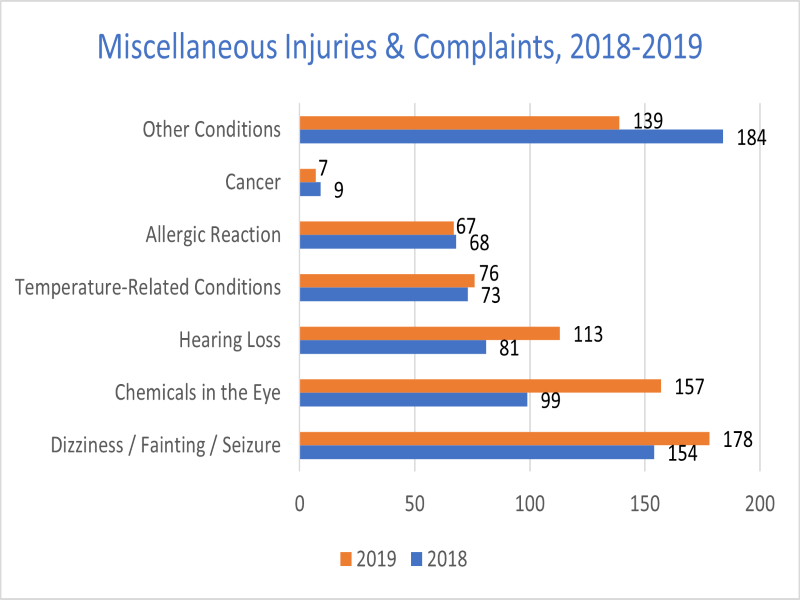
According to Connecticut’s 2020 Survey of Occupational Injuries and Illnesses, private industry employers reported 33,300 nonfatal workplace illnesses and injuries throughout the year. The resulting incidence rate of 3.0 cases per 100 workers was subsequently substantially higher than the national rate of 2.7. Two Connecticut supersectors, “trade, transportation, and utilities” and “education and health services” accounted for 67% of the occupational illnesses and injuries.
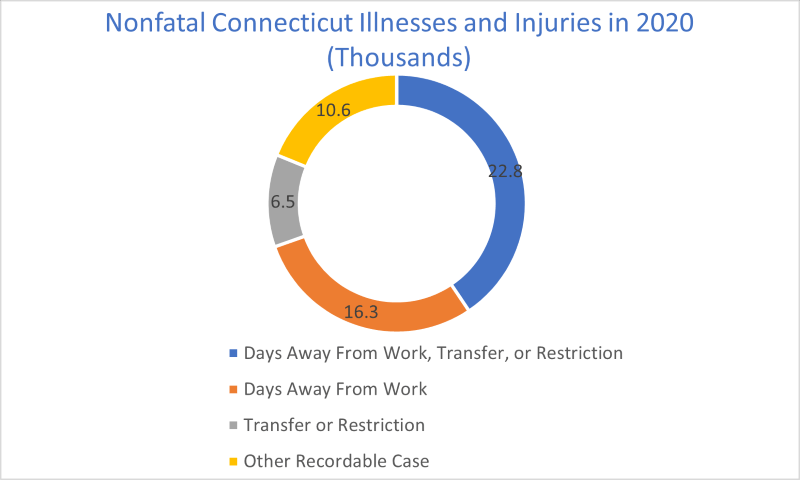
In 2020, the most recent year for which data of this nature is available, the BLS reported twenty-nine fatal occupational injuries in Connecticut. Twenty-seven of these deaths occurred in private industries. The chart below details the cause of death and victim’s age range. The totals may not add up to twenty-nine if a victim’s age or cause of death was not determined.
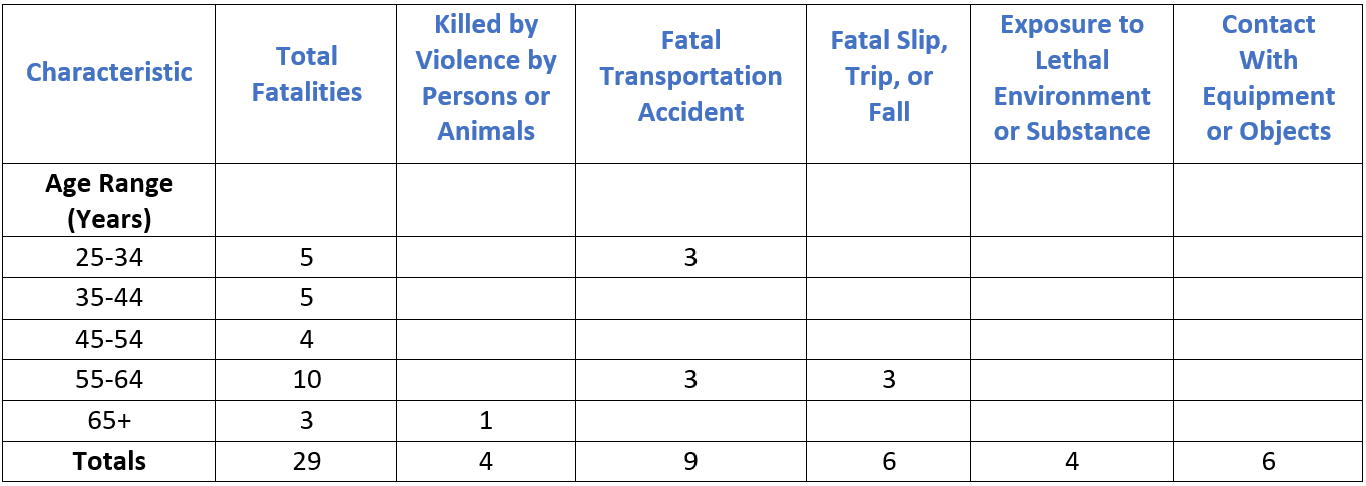
93% of the fatal workplace injuries suffered in Connecticut in 2020 occurred in the private sector. Similarly, 92% of all workplace fatalities across the United States during the same year occurred in the private sector. In the chart below, we compare the total number of workplace-related deaths nationwide by cause to those that occurred specifically in the private sector. Overall, 37% of workplace fatalities across the nation happened due to a transportation incident, of which 90% of incidents happened in the private sector.
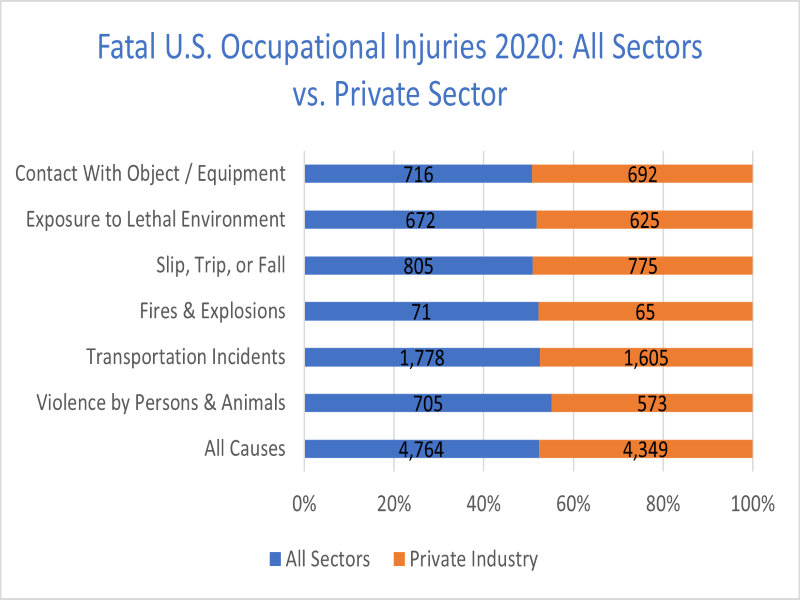
Although every town in Connecticut inevitably deals with some number of work-related illnesses and ailments, some areas certainly fare better than others. Using data gathered by CTDOL from 2019, we’re able to see which towns and municipalities experienced the highest numbers of illnesses over a one-year period. Plainfield had the highest rate of illnesses per 10,000 workers, at 93. However, Hartford had the highest number of reported illnesses in the year, at 110,997.
| Town | Cases | Employment | Rate Per 10,000 |
Rank |
|
Plainfield |
41 | 4,397 | 93 | 1 |
|
Vernon |
61 | 8,053 | 76 |
2 |
|
Cheshire |
117 | 16,794 | 70 |
3 |
|
Windsor Locks |
87 | 13,276 | 66 |
4 |
| Waterbury | 253 | 39,067 | 65 |
5 |
|
Groton |
171 | 28,306 | 60 |
6 |
|
Guilford |
47 | 8,033 | 59 |
7 |
|
Manchester |
155 | 27,731 | 56 |
8 |
|
Stratford |
136 | 24,431 | 56 |
9 |
|
Putnam |
31 | 5,927 | 52 |
10 |
|
Torrington |
74 | 14,841 | 50 |
11 |
|
New Milford |
39 | 7,941 | 49 |
12 |
|
Cromwell |
36 | 7,517 | 48 |
13 |
|
Mansfield |
55 | 11,739 | 47 |
14 |
|
Meriden |
103 | 22,727 | 45 |
15 |
|
Farmington |
144 | 32,136 | 45 |
16 |
|
Waterford |
47 | 10,604 | 44 |
17 |
|
Stonington |
32 | 7,740 | 41 | 18 |
|
Middletown |
116 | 28,112 | 41 |
19 |
|
Trumbull |
57 | 14,894 | 38 |
20 |
|
Newtown |
32 | 8,461 | 38 |
21 |
|
New Canaan |
25 | 6,685 | 37 |
22 |
|
South Windsor |
52 | 14,212 | 37 |
23 |
|
Watertown |
32 | 8,890 | 36 |
24 |
|
New London |
47 | 13,509 | 35 |
25 |
|
Newington |
58 | 17,077 | 34 |
26 |
|
Hartford |
370 | 110,997 | 33 |
27 |
|
Berlin |
39 | 11,809 | 33 |
28 |
|
Simsbury |
26 | 8,216 | 32 |
29 |
|
Bloomfield |
62 | 19,821 | 31 |
30 |
|
New Haven |
263 | 84,205 | 31 |
31 |
|
Windsor |
81 | 26,528 | 31 | 32 |
|
North Haven |
62 | 20,713 | 30 |
33 |
|
Danbury |
125 | 43,886 | 28 |
34 |
|
Wethersfield |
27 | 9,558 | 28 |
35 |
|
Bridgeport |
107 | 42,048 | 25 |
36 |
|
Rocky Hill |
41 | 16,130 | 25 |
37 |
|
Wallingford |
71 | 28,172 | 25 |
38 |
|
Montville |
31 | 12,427 | 25 |
39 |
| Enfield | 44 | 18,045 | 24 |
40 |
| New Britain | 58 | 24,599 | 24 |
41 |
|
Glastonbury |
40 | 17,216 | 23 |
42 |
|
Norwalk |
98 | 43,536 | 23 |
43 |
| West Hartford | 64 | 29,143 | 22 |
44 |
| Norwich | 36 | 17,410 | 21 |
45 |
|
Milford |
53 | 27,752 | 19 |
46 |
|
Hamden |
39 | 20,567 | 19 |
47 |
|
Greenwich |
62 | 33,671 | 18 |
48 |
|
Westport |
27 | 14,929 | 18 |
49 |
| Shelton | 46 | 25,873 | 18 |
50 |
|
East Hartford |
57 | 34,438 | 17 |
51 |
|
Bristol |
36 | 22,420 | 16 |
52 |
| Fairfield | 30 | 25,739 | 12 |
53 |
|
Stamford |
67 | 76,189 | 9 |
54 |
| Connecticut | 5,259 | 1,670,354 | 31 |
N/A |
This article is originally being written in March of 2022, so complete data on workers’ comp cases for the calendar year 2022 is not yet available. However, the Office of Workers’ Compensation Programs (OWCP) has released the following data, which is accurate through March 6th, 2022:

Suffering an injury can be terrifying and stressful, particularly if you’re harmed at your place of employment. If you, a friend, or a loved one are harmed, try to follow these steps:
https://www.bls.gov/iif/home.htm#2020
https://www.cga.ct.gov/2019/rpt/pdf/2019-R-0267.pdf
https://portal.ct.gov/-/media/WCC/publications/annual-reports/ar2019.pdf